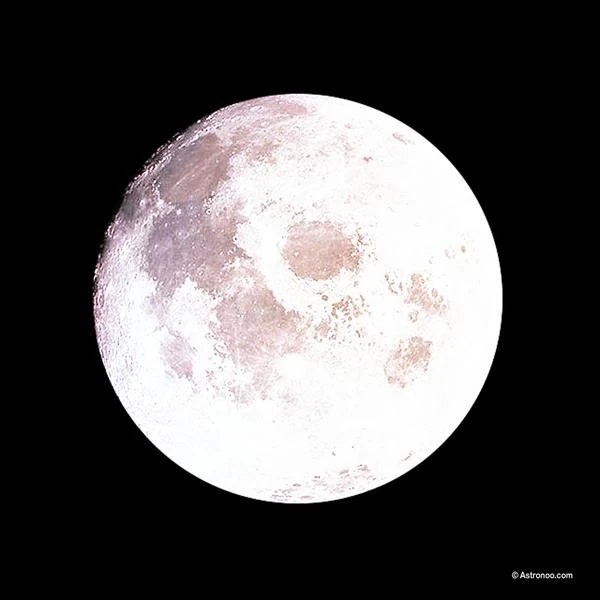
Image description: The term Supermoon was coined by astrologer Richard Nolle in 1979. The Supermoon occurs when the Moon is closest to Earth, making it appear larger and brighter than at any other time. The Supermoon is even more spectacular when it coincides with a full moon, at which point we observe a moon of great luminosity and magnificent brilliance. Image source: astronoo.com
The Moon, Earth's natural satellite, has an average diameter of \( D_L = 3,474.8\ \text{km} \). Its average radius is therefore \( R_L = 1,737.4\ \text{km} \), a value measured with great precision thanks to space missions and laser measurements taken from Earth. The Moon's diameter is about 3.7 times smaller than that of our planet. The lunar diameter varies slightly depending on the Earth-Moon distance, as the Moon's orbit is elliptical. Thus, at perigee, the Moon appears up to 14% larger than at apogee.
N.B.:
The Moon is almost spherical, with minimal polar flattening, indicating minimal deformation due to rotation. Its volume is about \(0.02\) times that of Earth.
The Moon moves at ≈1 km/s in an elliptical orbit, and its distance from Earth varies by about 50,000 km. At its apogee (farthest point from Earth), it is on average 405,700 km away, while at perigee, it is about 356,400 km away. The term Supermoon was coined in 1979 by astrologer Richard Nolle (1950-).
The Supermoon occurs when the Moon is closest to Earth: it is then larger and brighter than at any other time. The Supermoon is even more spectacular when it coincides with a full moon. At this time, we observe a moon of great luminosity and remarkable brilliance. When it is at perigee, it appears about 14% larger, a value corresponding to the difference between the two apsides (perigee and apogee) of the lunar orbit.
The Moon has an elliptical orbit around the center of the Earth, but reality is more complex. The double system of the Moon and Earth revolves around their common center of mass, called the barycenter. This barycenter, which is not fixed, varies depending on their average distance (≈384,400 km).
The barycenter is located on the Earth-Moon line, inside the Earth, about 1,708 km from the surface and about 4,670 km from the Earth's center (Earth's radius is ≈6,378 km). Since the center of mass of the Earth/Moon system is inside the Earth, we simply say that the Moon orbits the Earth. The Earth thus orbits a point that moves inside itself, tracing tiny spirals on its orbit: it waltzes with the Moon around the Sun.
Given the Sun's distance, its gravitational influence on the Earth/Moon barycenter is negligible, as from the Sun's perspective, the Earth-Moon pair forms an almost uniform gravitational field. This field is assimilated to that of a single body. However, there is also a Sun/(Earth/Moon) barycenter, calculable using the center of mass position formula.
Supermoons occur frequently (every lunar month), i.e., every 27 days, 7 hours, and 43 minutes. This corresponds to the sidereal revolution period of the Moon, also called the orbital period. This is exactly the time it takes the Moon to complete one full orbit around the Earth, or the time interval between two perigees (on average 27.55455 days).
Full moons occur every 29 days, 12 hours, and 44 minutes. This is the duration of the synodic cycle, i.e., the time required for the Moon to return to the same apparent configuration relative to the Earth and the Sun.
The coincidence between the Supermoon and the full moon occurs 1 to 5 times per year. In 2014, the Supermoon was about 14% larger and 30% brighter than a usual full moon, according to NASA measurements.
Apart from folkloric effects such as increased births, suicides, illnesses, crimes, social uprisings, and other natural disasters, the main effect of the Supermoon is obviously the tidal effect. During this period, the amplitude of ocean tides is at its maximum. In some places on Earth, the tidal range—the difference in height between high tide and low tide—exceeds 15 meters. The effects of a Supermoon on Earth are therefore minor.
However, according to studies by seismologists and volcanologists, the combination of the Supermoon (closest to Earth) and the full moon (alignment with Earth and Sun) should not affect the balance of Earth's internal energy, as there are lunar tides every day. The Earth has a huge amount of internal energy, and the small variations in tidal forces exerted by the Moon are not enough to fundamentally alter the internal balance that drives plate tectonics.